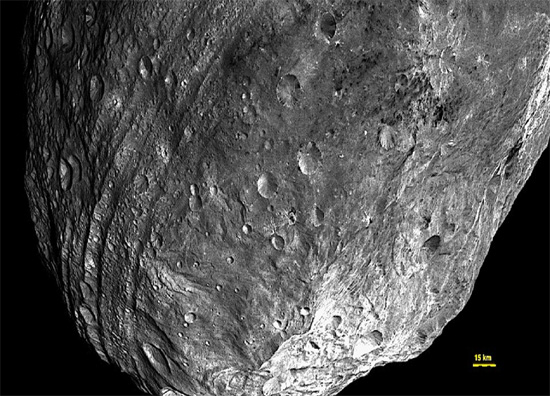
Equatorial grooves on Vesta. Credit: NASA/JPL-Caltech/UCLA/MPS/DLR/IDA
Mar 20, 2012
Vesta is confirming Electric Universe ideas about planetary scarring.
Vesta appears to have experienced some powerful forces. Several craters more than 50 kilometers in diameter mar its surface. Near Vesta’s south pole is a particularly large example that is 460 kilometers wide. Since Vesta has a mean diameter of 529 kilometers (Vesta is not quite spherical: 564 x 531 kilometers), it represents an impressive portion of the asteroid’s over all physical size. The crater is about 13 kilometers deep, with an 18 kilometer high central peak.
Dusty aggregations, or so-called “protoplanetary disks,” are thought to be where gravity pulls wispy gases together until they reach pressures great enough to ignite thermonuclear fusion. As the “Nebular Hypothesis” concludes, any remaining clumps of dust and gas not absorbed by the new star swirl around, attracting other bits, until they condense into planets. The Solar System is said to have been created in this way billions of years ago. Asteroids are typically considered to be the “leftovers” after the major planets and moons formed.
A close examination of Vesta’s surface casts doubt on the notion that the large craters could have been created by an object smashing into it, especially when those craters share walls that are thin and undisturbed by blast effects. The alternative explanation—formation by plasma discharge—is well supported.
The shallow craters, the overlapping rims and the lack of impact debris are important considerations in the theory of electrical effects. By thinking only in terms of meteor impacts, landslides and other familiar geological forces, NASA is ignoring the one possibility that makes all the disparate features they see cohesive: an electrically dynamic Solar System in its formative phases, when cosmic thunderbolts carved the surfaces of planets and moons.
In a standard Newtonian impact scenario, craters should form as dish-shaped holes with a blanket of blast debris surrounding the rims, sorted from largest to smallest particles depending on distance from the explosion. On Vesta, there is a decidedly different landscape. The craters are clean and most are found in collections, as if a shotgun blast struck the area.
The most obvious evidence for a plasma discharge is the steeply carved cliffs on Vesta. These features are not expected in an impact scenario. The visual evidence also reveals long canyons and furrows, some of which are ten kilometers wide, cut into the equator. A closer examination shows that those trenches (no matter what size) are chains of craters.
Asteroid formation does not require that one object smash into another one for there to be craters. Electric arcs can scoop out material, accelerate it into space, and leave behind deep pits. They tend not to disturb the surroundings, so they are used in industrial applications to finely machine metal parts. Based on laboratory analysis, that is what has occurred on Vesta: spark discharge erosion.
Planetary scientists ignore electrical explanations, which rectify the anomalies in other theories, because they know almost nothing about plasma and electric charge movement in space. Electricity can create the very things they are sending out probes to study.
Stephen Smith












